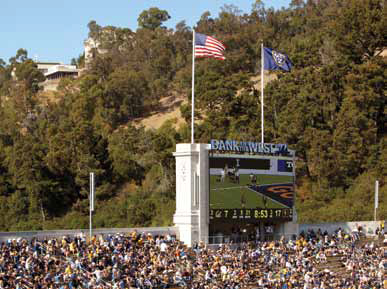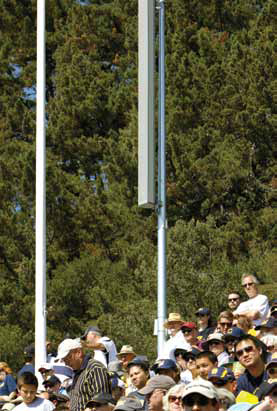Meyer Sound ’s First AVB Loudspeaker Makes a Direct Impression

Quick Bio
Name: John McMahon
Title: Executive Director of Operations and Digital Products
Company: Meyer Sound
Overtime: John McMahon has been at the forefront of digital audio technology used by Cirque du Soleil and theatrical productions worldwide. Working closely with consultants, sound designers and other end users, McMahon strives to make Meyer Sound’s digital audio technology accessible for the benefit of performers and audiences alike. Prior to joining Meyer Sound, McMahon was CEO at Level Control Systems (LCS Audio), and president at Cadence Digital Audio.
In a testament to the rapid speed at which the audio connectivity landscape is shifting, Meyer Sound recently completed development of its first AVB-capable loudspeaker— one of the industry’s first. This, however, is no ordinary AVBcapable loudspeaker. CAL, as is has been named, is a column array loud speaker (hence, CAL) capable of vertically steering beams of sound to aim directly at audience members without exciting an acoustic space. This steerability, which has also been introduced in products by the likes of Tannoy, Community, EAW, and Renkus-Heinz, is important for venues that are very reverberant— spaces with lots of hard surfaces. With CAL being AVB-capable, users can get these audio signals across an ethernet network using the new standards promoted by the AVnu Alliance.

The auditorium at Hong Kong University.“The demand for beam steering has existed for years,” stated John McMahon, Meyer’s executive director of operations and digital products, “and the product options in the marketplace provided varying results. Through our sound field synthesis research with the University of California Berkeley’s Center for New Music and Audio Technology (CNMAT), Meyer Sound was able to develop beam steering techniques that achieved unprecedented accuracy. This level of control and on- and off-axis sound quality are what make CAL such a unique product.”
In some applications, CAL’s beam-splitting capabilities can even be used to cover the main audience and the balcony seating while minimizing reflection from the balcony. Sound, as a result, can be accurately directed at the people who are supposed to hear it.
With CAL not being the first column array on the market, Meyer set out do differentiate its product from the field. “Physics will tell you that there is no

Memorial Stadium at UC Berkeley.shortcut to attain the precision beam control for the range of frequencies in CAL,” said McMahon. “What separates CAL is its performance, the result of a combination of engineering details and digital advancements, including its number of high-frequency and low-frequency drivers and the minimal spacing between each element, the optimized bi-amped configuration with very carefully selected crossover, as well as the dedicated DSP processing and amplification for each driver element. The evidence of all of this is in the hearing.”
A daily selection of the top stories for AV integrators, resellers and consultants. Sign up below.
If user feedback is any gauge, there is plenty of evidence to go around. “We measured an STI-PA average at 0.70 throughout the seating bowl,” exclaimed Jack Wrightson, principal at WJHW, the acoustical consultant on the audio install at UC Berkley’s Memorial Stadium, “which is exceptional for a football stadium.”
Nick Carroll, operations manager for sound at the Arts Centre of Melbourne offered similar praise “We have used CAL for a number of performances, and we are tremendously pleased with the performance. The frequency and phase response are extremely flat, and the level difference between the front and the rear of the stalls is minimal to the point of amazement.”
Reviews like that don’t come without a significant amount of research. Indeed, the research and development process on CAL was as rigorous as they come. In the prototype stage, Meyer worked with CNMAT at UC Berkley to model various types of beam forming. “This allowed us to create a prototype in an icosahedron, which is a 20-sided loudspeaker,” explained McMahon. “It has 120 small 1¼-inch drivers to replicate the radiation pattern of any sound source. This research greatly advanced our understanding of grating lobes, maximum frequencies, how tightly we had to pack the drivers, and the types of processing required.”

CAL stands tall at Memorial Stadium.With the intention of providing an intelligibility and coverage control solution to settings such as airports, convention centers, cathedrals, stadiums, shopping malls, and retail spaces, McMahon said that Meyer has been doing a number of live demonstrations at numerous trade shows, including InfoComm, to showcase CAL’s capabilities. “Like all loudspeaker products, it’s important for our system designers and consultants to hear the product, and this is especially essential for understanding the level of control CAL provides.”
In order to simplify the design process for consultants and other system designers, Meyer has made CAL available in the GLL format. “This allows users of the EASE design and simulation software to model the interaction of CAL with the acoustics of the room,” he said.
According to McMahon, CAL has garnered great reception since it began shipping last year. It has been installed in the Memorial Stadium at UC Berkeley, the Chan Centre for Performing Arts in Vancouver, BC, Canada, Hong Kong University, Hamer Hall in Melbourne, Australia, and cathedrals in Italy and Russia.
“The CAL solution was just brilliant,” stated Joe Diesko, vice president of HN TB, the architect for the Memorial Stadium project. “They look great, and they sound fabulous.”
Chuck Ansbacher is the managing editor of SCN.
